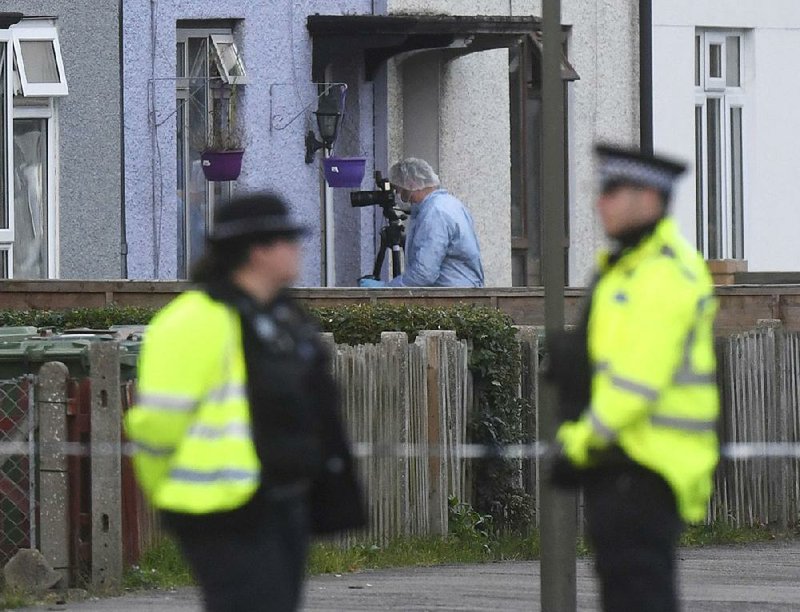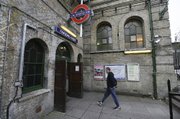LONDON -- British police made an apparent breakthrough Saturday in a race-against-time subway bombing investigation with what they called a "significant arrest" as the country remained on a "critical" alert, meaning that another attack is considered imminent.
Police arrested an 18-year-old man in the port of Dover -- the main ferry link to France -- and then began a widespread armed search in the southwestern London suburb of Sunbury in which they evacuated residents, established a cordon and imposed a no-fly zone over the property being searched.
Police would not say whether they had found the man believed to have planted the bomb that partially exploded on a crowded London subway train Friday morning, but Home Secretary Amber Rudd and others said the arrest was of major importance.
"We have made a significant arrest in our investigation this morning," Deputy Assistant Commissioner Neil Basu, the top counterterrorism official at the Metropolitan Police in London, said in a statement.
"Although we are pleased with the progress made, this investigation continues and the threat level remains at critical," the statement said. The man in custody wasn't identified by police.
The man is being held under the Terrorism Act and has been taken to London for questioning. His identity is a closely guarded secret, and police have implored the media not to speculate while the inquiry unfolds. Authorities would not say whether they believed the man was trying to flee to France on a Dover ferry.
The Metropolitan Police said a major hunt was still underway Saturday for any other suspects connected to the subway bombing. Police in Kent warned residents in a statement on Twitter to expect more officers and "military personnel" on the streets.
Hundreds of soldiers patrolled public areas Saturday, freeing up police for the bombing investigation. Rudd said the country's terror threat level -- which was raised Friday night to the highest possible level -- will stay there until the independent Joint Terrorism Analysis Center is convinced that the threat of imminent attack has eased.
The homemade bomb on the rush-hour train only partially detonated. Rudd said the blast could have been much worse. There were fears Saturday that the suspect in custody had accomplices who may have similar devices. Experts said the bomb could have caused many fatalities if it had functioned properly. Three of the 29 people injured in the blast remained hospitalized Saturday.
Ben Wallace, the security minister, told the BBC's Today radio program that the homemade bomb contained triacetone triperoxide, an explosive similar to the one used in the Manchester Arena bombing in May.
Rudd, frustrated by the string of terrorist attacks in recent months, said officials will have to work harder to make bomb components more difficult to obtain.
"[We must] make sure to take all steps that we can to ensure the sort of materials that this man was able to collect" are harder to find, she said.
The fast-moving inquiry shifted to the pleasant town of Sunbury, where police ordered neighbors to evacuate immediately.
Sunbury is 10 miles west of Parsons Green, where the explosion occurred. Residents reached by phone Saturday said that shortly before 2 p.m., police officers arrived in the residential neighborhood around Cavendish Road and Burgoyne Road.
After police sealed off the surrounding streets, some residents were offered transportation to a local rugby club, and others were allowed to go to relatives' homes nearby.
Louise Margetts, 54, said she was returning from the supermarket to her home when she saw four police vehicles, including a police canine unit, speeding up the road.
"The officers at the back jumped out and started cordoning off the road," she said. "They were running, and said, 'Turn around now.'"
Margetts, a teacher, managed to get home, but police arrived at her door soon afterward.
"They didn't really tell us anything," she said. "They knocked, well, hammered, on the door and said: 'Out now. We can't say why.'"
Mojgan Jamali, who lives near the house being searched, said police gave her "one minute" to pack.
"I was in my house with my children, and there was a knock at the door from the police. They told me to leave. They said 'You have one minute to get out of the house and get away,'" she said. "I just got out. I got my three children, and we left the house and the street."
Police did not reveal details about the search. The Islamic State group has claimed that one of its units planted the subway bomb.
Barry Sutton, 53, said he saw several Surrey police vehicles on the edge of the cordoned area.
"The police are going house to house behind the tape, evacuating people," he said by phone. "There was no sense of panic, but there were a lot of police; it was a proper operation."
Sunbury is close to London's outermost boroughs and is served by commuter trains, but is not on the London Underground network.
Security at seaports and airports was increased after the attack. Officials have hinted that they suspect more than one person was involved in the blast, but they haven't released details.
Police are scouring closed-circuit TV images and have extensively studied the remains of the partially detonated explosive device, which was contained in a bucket with wires hanging out of it and concealed in a plastic shopping bag.
The subway train at the Parsons Green station in southwest London had video cameras in each car, and the London Underground network has thousands of cameras at the entrances to stations and along its labyrinth of subterranean and aboveground passageways.
The Parsons Green station reopened Saturday, restoring some normalcy to London's transportation network after a day of disruption. There was no sign of panic among Londoners and the weekend life of the multicultural city continued undeterred.
Premier League soccer games and London Fashion Week proceeded as usual, with an increased security presence, although animal-rights activists did hamper people trying to enter the Burberry fashion show Saturday night in central London.
Friday's detonation was the first to hit mass transit in London since the deadly bombings of 2005 that killed 52 people. While Londoners expressed relief that no one was killed in Friday's blast, the episode renewed fears about the threat of terror.
"This has become the new normal," said Harry Walker, a Parsons Green resident. "We get attacked, and then we carry on, waiting in anticipation for the next one."
"The fact that they struck Parsons Green," he added, "which is way out from the center, is them giving a very clear message: 'We can do it anywhere at any time.'"
Britain has endured four other attacks this year, which have killed a total of 36 people. The other attackers in London -- near Parliament, on London Bridge and near a mosque in Finsbury Park in north London -- used vehicles and knives. Most of the attacks have been claimed or praised by the Islamic State.
In addition, a suicide bomber struck a packed concert hall in Manchester in northern England, killing 22 people. That attack in May also briefly caused the nation's threat level to be set at "critical."
Information for this article was contributed by Gregory Katz of The Associated Press; by Ceylan Yeginsu and Stephen Farrell of The New York Times; and by Emma Ross-Thomas, Thomas Penny, Benjamin Katz, Christopher Kingdon, Joe Easton, Thomas Seal and Tim Ross of Bloomberg News.
A Section on 09/17/2017

